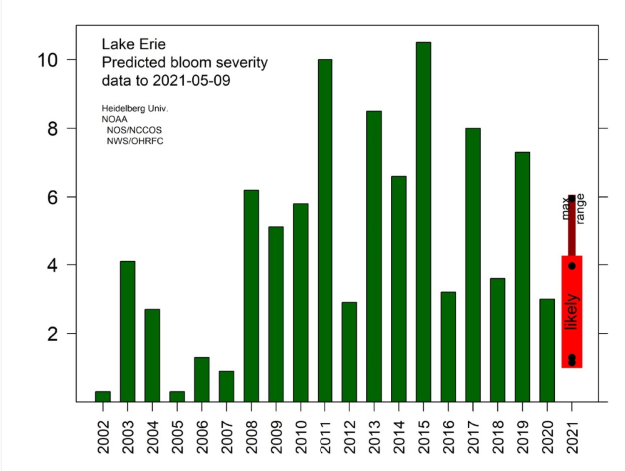Western Lake Erie is expected to experience a lower than average harmful algal bloom (HAB) this summer, according to the first 2021 Lake Erie Harmful Algal Bloom Early Season Projection issued by NOAA’s National Centers for Coastal Ocean Science (NCCOS), with support from the National Center for Water Quality Research at Heidelberg University.

Figure 1. Projected bloom compared to previous years. The wide bar is the likely range of severity based on limits of model uncertainty. The narrow bar is the potential range of severity. Because the forecast uses modeled discharge for a month, there is uncertainty in maximum bloom severity. Credit: NOAA, Heidelberg University
Projections of the bloom’s severity will be issued weekly through late June. On June 30, NOAA will issue the official Lake Erie HAB Seasonal Forecast via a virtual webinar co-hosted with Ohio Sea Grant. Click here to subscribe to the HAB forecasts and seasonal projections for Lake Erie.
We expect this year’s Lake Erie bloom to be smaller than 2017 and 2019 blooms. March and April rains and associated discharge and phosphorus loads for the Maumee River have been lower than average. Models currently indicate a likely severity of less than 4.5, but the uncertainty in these forecasts indicate a potential severity of up to 6 (still less than the 7.5 severity observed in 2019). Blooms with a severity index above 5 generally pose greater risk to drinking water and recreation in Lake Erie, but the impact of a bloom also depends on its location, toxicity, and duration. The largest blooms, 2011 and 2015, were 10 and 10.5, respectively (Figure 1).
The severity of the western Lake Erie cyanobacterial HAB depends on input of total bioavailable phosphorus (TBP) from the Maumee River during the loading season (March – July). The NOAA forecast gives an estimate of potential bloom severity based on a combination of TBP measurements to date collected by Heidelberg University and forecasts of river discharge (by NOAA’s Ohio River Forecast Center) and phosphorus loads from now into July.
Above average rain events are expected for the rest of May and are included in the forecast. There is still uncertainty in the projected maximum severity of the bloom due to limitations in forecasting the exact location and amount of rainfall the rest of May. In June, we expect a return to normal rainfall with less uncertainty.
The cone of uncertainty for this forecast will continue to narrow as additional rain and river discharge data is collected over the next two months. Any bloom that develops will change with time and move with the wind, and NOAA will provide information on the presence and location of any bloom throughout the summer.
This is one of several ecological forecasts developed by NOAA and its partners.
 Official websites use .gov
A .gov website belongs to an official government organization in the United States.
Official websites use .gov
A .gov website belongs to an official government organization in the United States. Secure .gov websites use HTTPS
A lock or https:// means you’ve safely connected to the .gov website. Share sensitive information only on official, secure websites.
Secure .gov websites use HTTPS
A lock or https:// means you’ve safely connected to the .gov website. Share sensitive information only on official, secure websites.